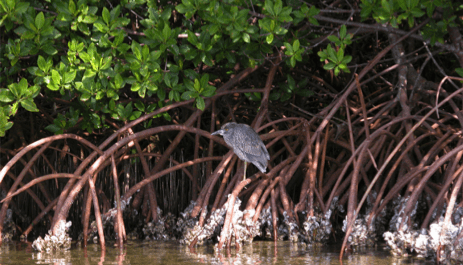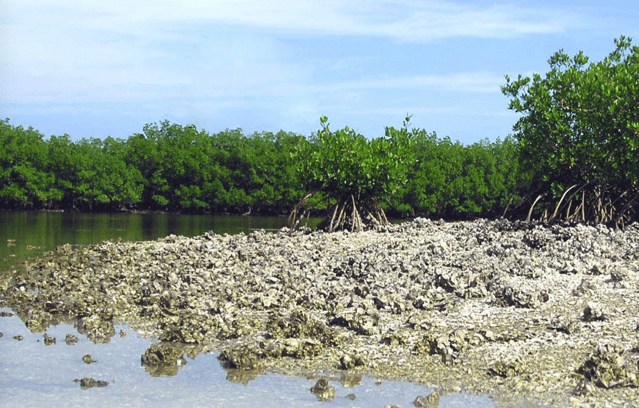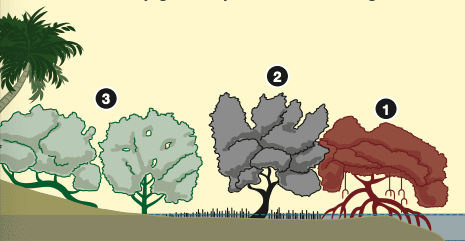Homeowner Guidelines for Trimming Mangroves

Mangroves are tropical trees that grow in calm intertidal areas where temperatures do not usually drop below freezing for prolonged periods. They provide many important benefits to the residents of Pinellas County such as:
- Controlling shoreline erosion.
- Protecting homes from wind and storm surge.
- Maintaining water quality.
- Starting the marine food web.
- Creating critical habitat and nursery areas.
- Supporting recreational and commercial fishing.
- Creating a healthy natural environment for all of our residents and visitors to enjoy.

Since the 1940s, Florida has lost about 86% of its mangroves. In the Tampa Bay region, we’ve lost 50% of our historic mangrove coverage. Pinellas County has managed these important resources since the 1970s.
In 2003, the Board of County Commissioners, with the assistance of a citizen advisory committee, adopted the Pinellas County Mangrove Trimming and Preservation Code, which now provides the sole regulation over mangroves in Pinellas County. This code also recognizes the importance of waterfront views and this page is intended to assist coastal property owners in complying with Pinellas County’s mangrove trimming criteria.
Trimming Mangroves
To trim mangroves in Pinellas County, you must either qualify for one of the exemptions in the code or obtain a permit. The following information summarizes the criteria for both exempt and permitted trimming.

General Trimming Criteria
Regardless of whether you are trimming under an exemption or a permit, the following criteria apply:
- The mangroves must be located on lands that you own or on state-owned sovereign submerged lands adjacent to your property.
- The mangroves must not be located in an area set aside for conservation, mitigation or preservation, such as through a previous permit, site plan, conservation easement or enforcement action.
- No mangrove may be trimmed to less than six feet in height as measured from the substrate (mud).
- No mangroves may be removed, destroyed or defoliated, which means that some trees may not be able to be reduced to six feet or may have to be reduced in stages over time. No prop roots may be cut.
- A professional mangrove trimmer (PMT) registered with Pinellas County must be used if the mangroves are over 10 feet in height. The PMT must notify Pinellas County Water and Navigation in advance of any trimming and be onsite during the trimming.
- Mangroves over 16 feet in height must be trimmed in stages so that no more than 25% of the foliage is removed annually.
- No herbicides or chemicals may be used.
Exempt Trimming
You are authorized to trim without a permit if you meet all of the General Trimming Criteria and meet all of the following conditions:
- The mangroves are less than 50 feet in depth, measured perpendicular to the shoreline from the most landward to the most waterward trunk.
- The mangroves to be trimmed are not over 24 feet in height.
- If your shoreline is over 150 feet in length, no more than 65% of the total mangrove area may be trimmed.
- The mangroves are not located on an uninhabited island.
There is also an exemption for the “maintenance trimming” of mangroves, provided they were legally trimmed in the past and maintained over the years. If you are unsure about any of these exemptions, we recommend you contact us before trimming. If desired, staff can meet with you to confirm that your project qualifies as exempt trimming.
Permitted Trimming
You will receive a permit to trim if you meet all of the General Trimming Criteria and meet all of the following conditions:
- The mangroves are less than 500 feet in depth, measured perpendicular to the shoreline.
- A maximum of 65% of the mangroves may be trimmed.
- 25% of the mangroves in the trimmed area that are over 16 feet tall have their canopies left intact.
- Trimming must occur between March 1 and November 30.
- Non-petroleum based lubricants must be used in chain saws.
- Brazilian pepper trees (Schinus terebinthifolius), punk trees (Melaleuca quinquenervia) and Chinese tallow (Sapium sebiferum) within 25 feet of any mangroves must be removed.
- All trimmed branches and trunks must be removed.
All applications for trimming permits will be reviewed within 30 days.
Mangrove Species in Pinellas County
- Red mangroves (Rhizophora mangle) have long aerial prop roots that extend from the trunk and branches into the water. They have waxy bright green leaves and pencil-like seedlings that hang from the branches. Red mangroves are very sensitive to trimming, especially topping, and caution must be used when they are trimmed.
- Black mangroves (Avicennia germinans) grow taller and more tree-like. They have dark bark and finger-like roots that project from the mud. The upper surface of the black mangrove leaf is darker than the lower side and is often covered with salt. Larger black mangroves are also difficult to top without harming the tree and therefore they are often trimmed laterally to provide views under their canopy.
- White mangroves (Laguncularia racemosa) are generally smaller and more shrub-like in this area. They have oval-shaped leaves with two small visible glands at the base of each leaf. They generally tolerate trimming.

Shoreline owners have a unique opportunity to directly participate in the stewardship of our marine environment. There are many ways to obtain water views and maintain the valuable functions of our mangrove communities. Please keep in mind that the criteria described on this page represent the maximum trimming that can occur on your property. You’re encouraged to look for creative ways to obtain views that minimize trimming in order to maximize the benefits that mangroves provide.
Visit our Mangroves page for a list of professional mangrove trimmers, applications for mangrove trimming permits and a complete copy of the code.
If you have any questions, please do not hesitate to contact us at (727) 453-3385.